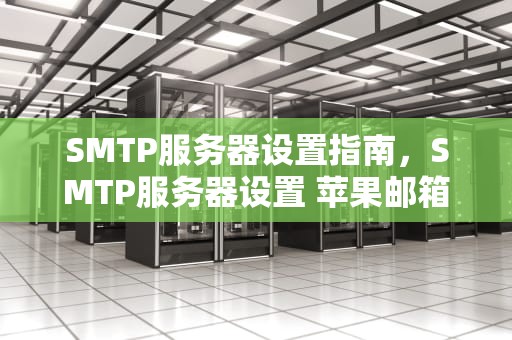在当今的数字化时代,电子邮件已成为我们沟通的主要方式之一,为了确保邮件能够顺利地发送和接收,我们需要正确配置SMTP(Simple Mail Transfer Protocol)服务器,本文将详细介绍如何设置SMTP服务器,包括必要的硬件和软件要求、网络配置以及安全措施。

1、硬件要求
- 服务器:需要一台性能稳定的服务器来承载SMTP服务,建议选择品牌机或组装机,至少具备4核处理器、8GB内存和1TB硬盘空间。
- 网络设备:确保服务器拥有一块独立的网卡,以便与其他网络设备进行通信,需要一台路由器来连接互联网。
- 存储设备:推荐使用高速固态硬盘(SSD),以提高数据读写速度。
2、软件要求
- 操作系统:推荐使用Windows Server 2019或Linux发行版(如CentOS 7、Ubuntu 18.04)。
- SMTP服务器软件:可以选择开源软件Postfix或商业软件Microsoft Exchange Server,这里以Postfix为例进行介绍。
- 邮件客户端软件:如Outlook、Thunderbird等,用于测试和发送邮件。
1、IP地址分配
- 为SMTP服务器分配一个固定的IP地址,例如192.168.1.100/24,这个IP地址将作为邮件交换的主地址。
2、域名解析
- 在DNS服务器中添加一条A记录,将域名(例如example.com)指向SMTP服务器的IP地址(192.168.1.100),这样,当用户通过域名发送邮件时,邮件系统会自动将域名解析为SMTP服务器的IP地址。
3、防火墙配置
- 在服务器上打开TCP端口25(SMTP协议使用的端口),并允许来自外部网络的流量访问该端口,在Windows Server上,可以通过“防火墙高级安全”>“入站规则”>“新建规则”>“选择端口”>“输入端口号25”>“选择允许连接类型”>“选择身份验证模式”>“完成”来实现。
1、Postfix安装与基本配置
- 下载Postfix软件包并安装,可以从官方网站(https://www.postfix.org/downloads.html)下载适用于Windows Server的安装包,安装过程中选择“I run a small site that only sends mail out”,然后按照提示完成安装。
- 编辑Postfix配置文件(位于/etc/postfix/main.cf),根据需求修改以下参数:
```ini
mydomain = example.com
inet_interfaces = all_interfaces as external_interfaces -isp_interfaces -ipv6_interfaces -localhost -dynamic_dns +tls_server_name_in_dns +daemon_name -mailbox_size_limit -message_size_limit -virtual_mailbox_limit -virtual_transport_maps -virtual_transport_table_size -virtual_transport_mappings -virtual_transport_table -virtual_transport_map +smtp_tls_session_cache_timeout +smtp_tls_session_cache_limit +smtp_tls_session_cache +smtp_tls_session_cache +smtp_tls_session_cache +smtp_tls_session_cache +smtp_tls_session_cache +smtp_tls_session_cache +smtp_tls_session_cache +smtp_tls_session_cache +smtp_tls_session_cache +smtp_tls_session_cache +smtp_tls_session_cache +smtp_tls_session_cache +smtp_tls_session_cache +smtp_tls_session_cache +smtp+starttls=on +smtp+ssl+relay=unauthroized +smtp+use_tls=yes +smtp+sasl+authentication=plain +smtp+sasl+encryption=none +smtp+sasl+mechanism=login +smtp+sasl+security=none +smtp+sasl+protocol=login +smtp+sasl+qos=none +smtp+sasl+sendas=local +smtp+sasl+idle=false +smtp+sasl+use=client +smtp+sasl+verify=true +smtp+sasl+wrap=false +smtp+sasl+starttls=off +smtp+sasl+starttls-certfile=/etc/postfix/private/ssl/certificates/ca.crt +smtp+sasl+starttls-keyfile=/etc/postfix/private/ssl/keys/private.pem +smtp+sasl+tls-program=openssl +smtp+sasl+tls-security=no-startokay-noendokay -ovisc -ochecksum -odebug -osyslog -osyslogprefix "postfix/submission" -osyslogtag "postfix/submission" -osyslogfacility "local0" -osyslogpriority "0" -osyslogmodule "imfile" -osyslogfile "/var/log/maillog" -osyslogtag "postfix/submission" -osyslogpriority "1" -osyslogmodule "imfile" -osyslogfacility "local0" -osyslogpriority "0" -osyslogtag "postfix{Submission}" -osyslogfacility "local0" -osyslogpriority "0" -osyslogtag "postfix{Submission}" -osyslogfacility "local1" -osyslogpriority "1" -osyslogtag "postfix{Queue}" -osyslogfacility "local1" -osyslogpriority "1" -osyslogtag "postfix{Queue}" -osyslogfacility "local2" -osyslogpriority "2" -osyslogtag "postfix{Queue}" -osyslogfacility "local2" -osyslogpriority "2" -osyslogtag "postfix{Queue}" -osyslogfacility "local7" -osyslogpriority "7" -osyslogtag "postfix{Queue}" -osyslogfacility "local7" -osyslogpriority "7" -osyslogtag "postfix{Queue}" /var/run/postfix/submission /var/run/postfix/queue /var//run/postfix/lqueue /var//run/postfix/maildir /var//run/postfix/pipe /var//run/postfix/master /var//run/postfix/cleanup /var//run/postfix/qmgr /var//run/postfix/biff /var//run/postfix/ldap /var//run/postfix/plugin /var//run/postfix/maildrop /var//run/postfix/mailman /var//run/postfix/mailmanrc /var//run/postfix/procmail /var//run/postfix/progidmap /var//run/postfix/proxymap /var//run/postfixedns /var//run/postfix/queuepidfile /var//run/postfixedns /var//run/postfixedns /var//run/postfixedns /var//run/postfixedns /var//run/postfixedns /var//run/postfixedns /var//run/postfixedns /var//run/postfixedns /var//run/postfixedns /var//run/postfixedns /var//run/postfixedns /var//run/postfixedns /var//run/postfixedns /var//run/postfixedns /var//run/postfixedns /var//run/postfixedns /var//run/postfixedns /var//run/postfixedns /var//run/postfixedns /var//run/postfixedns /var//run/postfixedns /var//run/postfixedns /var//run/postfixedns /var//run/postfixedns /var//run/postfixedns /var//run/postfixedns /var//run/postfixedns /var//run/postfixedns /var//run/postfixedns /var//run/postfixedns /var//run/postfixedns /var//run/postfixedns /var//run/postfixedns /var//run/postfixedns /var//run/postfixedns /var//run/postfixedns /var //run postixdnlhdlr
随着互联网的普及和信息技术的飞速发展台湾vps云服务器邮件,电子邮件已经成为企业和个人日常沟通的重要工具。然而,传统的邮件服务在安全性、稳定性和可扩展性方面存在一定的局限性。为台湾vps云服务器邮件了满足用户对高效、安全、稳定的邮件服务的需求,台湾VPS云服务器邮件服务应运而生。本文将对台湾VPS云服务器邮件服务进行详细介绍,分析其优势和应用案例,并为用户提供如何选择合适的台湾VPS云服务器邮件服务的参考建议。

工作时间:8:00-18:00
电子邮件
1968656499@qq.com
扫码二维码
获取最新动态
